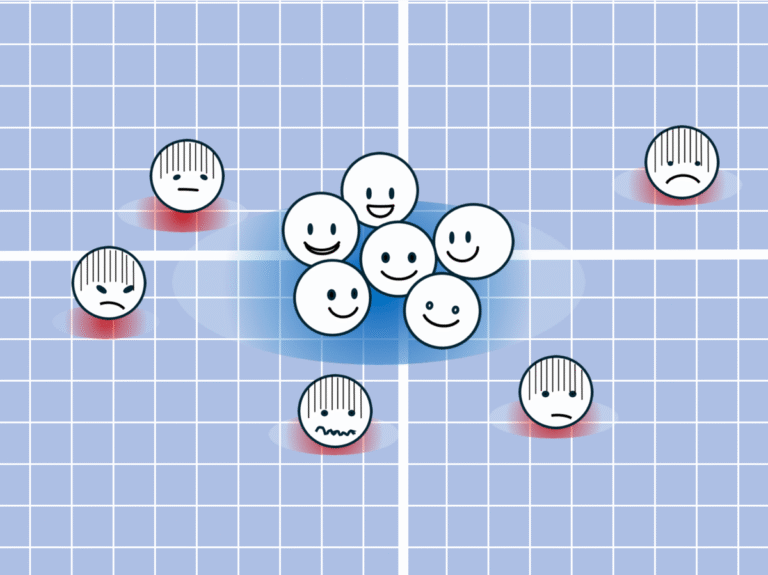Optimists Are Alike, but Pessimists Are Unique, Brain Scan Study Suggests
Optimists have similar patterns of brain activation when they think about the future—but pessimists are all different from one another, a brain scan study suggests
A new study shows that when people think about future events, optimists’ neural activity patterns are mutually similar—but pessimists’ patterns are much more diverse.
ASANO Kohei, SUGIURA Hitomi
“All happy families are alike; each unhappy family is unhappy in its own way.” This is the first line of Leo Tolstoy’s novel Anna Karenina, and it may hold a kernel of truth that goes beyond family dynamics. In a recent study of optimism, neuroscientists found an equivalent principle at play: optimists shared similar patterns of activity in a key brain region when they imagined future events, but each pessimist’s brain patterns was unique. The results help neuroscientists understand what distinguishes optimism from pessimism in the brain. This is an important question because optimism is associated with better physical, mental and social health. The results were published on Monday in the Proceedings of the National Academy of Sciences USA.
“We tend to think of imagining the future as a deeply personal, subjective act,” says Kuniaki Yanagisawa, the study’s lead author and a psychologist at Kobe University in Japan. “Our study, however, shows that—especially for optimists—the way our brains do this can be similar” and suggests that such shared cognitive frameworks for imagining the future might explain why we “click” with some people, he says.
Prior studies have shown that optimists have larger social networks and higher acceptance by their peers. Yanagisawa wanted to understand “whether this social success is just about personality,” he says, “or if optimists might share a fundamental brain mechanism that makes it easier for them to form social connections.”
On supporting science journalism
If you’re enjoying this article, consider supporting our award-winning journalism by subscribing. By purchasing a subscription you are helping to ensure the future of impactful stories about the discoveries and ideas shaping our world today.
The researchers scanned participants in a functional magnetic resonance imaging (fMRI) machine while they imagined specific future events happening to either them or their spouse. Some of the events were positive; others were neutral or negative. Afterward the team had the participants take a questionnaire to determine their level of optimism or pessimism. The researchers conducted the study twice, once in a group of 37 participants and again in a group of 50.
To analyze the brain scans, the researchers zoomed in on one region that’s particularly active while imagining future events: the medial prefrontal cortex, located in the middle of the very front of the brain. They compared patterns of brain activation in each possible pair of participants and used statistical tests to determine how similar the activations were to each other in these pairs. The team found that only pairs consisting of two optimistic participants had similar brain activation; pairs where one or both participants were more pessimistic were dissimilar to each other. The researchers also found that optimistic people showed bigger differences between brain patterns for emotionally positive and negative events than pessimists did.
A few prior studies of “positive” social traits have shown similar results. A 2022 brain scan study showed that people who held a central position in their social network have similar activation patterns to one another—but that less central people had a lot of individual differences, or idiosyncrasies. The same pattern held true in another study of people with low versus high levels of loneliness. Elisa Baek, a social neuroscientist now at the University of Southern California and lead author of those two studies, refers to these results as examples of the “Anna Karenina principle,” the idea that successful endeavors have similar characteristics but that unsuccessful ones are each different in their own way.
“One intriguing interpretation [of the optimism study], consistent with the Anna Karenina principle, is that there may be many different ways for a person to be pessimistic, while optimistic people tend to converge on a few shared mental models of a hopeful future,” Baek says. Together, these studies “may point to a more general principle—that being ‘on the same page’ as others is a foundational mechanism that underlies the experience of social connection.”
If there is an Anna Karenina principle at work for positive social traits, what would be causing it? After all, the traits we deem “positive” vary greatly among different societies, so there’s a risk of cultural bias. Yanagisawa thinks that these cultural values could actually be driving the effect—they orient people toward a specific goal that is valued in a society, such as being optimistic or having a lot of social connections, perhaps leading those individuals to behave and think similarly over time.
It’s also possible that optimism, as measured in this study, is picking up on related traits such as people’s level of loneliness or position in a social network. “These convergent findings raise an important question about the overlap between constructs such as optimism, loneliness and network centrality,” Baek says. “Because the new study didn’t control for loneliness or social network position, and my prior work didn’t control for optimism, it is unclear how much these dimensions are overlapping or distinct.”
Optimism and pessimism aren’t unchanging traits; they tend to shift with age, although the trajectories vary from culture to culture. Nor is optimism an unquestioned good. “Extreme optimism might not always be a good thing because we might not plan for the future as well as we should,” says Aleea Devitt, a psychologist at the University of Waikato in New Zealand, who studies future thinking. And “pessimism may be a useful ‘positive’ trait in some situations; there’s evidence that some people can be defensive pessimists, which can actually help them better prepare for the future.”
